Sports
A script gone sour!
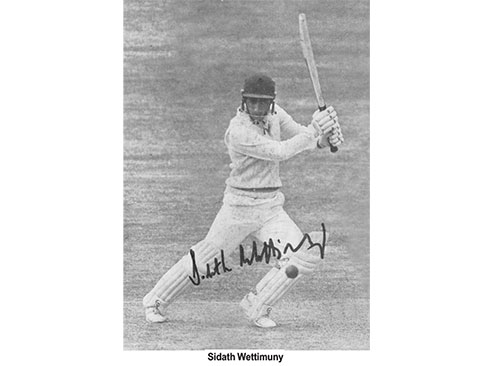
36th Anniversary of Sri Lanka’s first ever Test match at Lord’s – Part 1
by Rohan Wijeyaratna
“We’ve actually come here” said the middle-aged man seated next to me, “to watch a proper game of cricket”. Dressed in jacket and a gaudy ‘bacon and eggs’ tie, he was with a group of four others, settling into their seats in the upper tiers of the New Tavern Stand, with the expectation of witnessing an enjoyable day’s cricket. The drift of their conversation seemed no different to the sentiments expressed in the English press and elsewhere, that the game about to begin would be agreeably one sided. Many felt England had a great opportunity of redeeming themselves after the fearful thrashing they received at the hands of the West Indies, earlier that summer.
No one could fault such sentiment. Sri Lanka’s lead up to their first Test at Lord’s had been less than impressive. Beginning 25th July, the Lankans played Nottinghamshire, Surrey, Gloucestershire, Hampshire, Kent, Sussex and Warwickshire and – barring Kent – they failed to bowl out any of the other sides even once. Also, they lost to Surrey. “Not much better than Cambridge University” was the honest appraisal of an experienced county coach, without stooping to insult. Going by the match results at the time, that seemed fair comment.
England’s rough summer
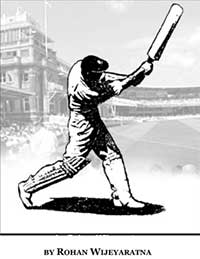 This was 23rd August 1984. England had suffered a complete ‘blackwash’ earlier that summer at the hands of the West Indies, losing 5-0. The pounding was so intense and intimidating, it prompted cricket sages like Jim Swanton to suggest the drawing of a mandatory line across the wicket, compelling bowlers to pitch beyond it. That the West Indians derived most of their menace through their unrelenting pace there was no doubt, but the extent to which they used the short pitched delivery made it seem that batting was as much an exercise in self defense as it was, in defense of the wicket. Even night-watchmen weren’t spared. Batsmen literally jumped out of their skins with both feet off the ground, trying to keep the ball down, or frantically swaying out of the way to avoid grievous injury. The bowlers were like men possessed. There were not just one or two of them, but often four in tandem; all delivering at furious pace, unrelenting fury and unerring accuracy. Importantly, they were all pitched short of a good length. Whichever side of the divide one belonged, there was no denying this was violent cricket, which fell way short of the game’s famed chivalry. Given all of that, the Sri Lankan match at the tail end of the summer, was expected to offer the perfect antidote to what had gone on before.
This was 23rd August 1984. England had suffered a complete ‘blackwash’ earlier that summer at the hands of the West Indies, losing 5-0. The pounding was so intense and intimidating, it prompted cricket sages like Jim Swanton to suggest the drawing of a mandatory line across the wicket, compelling bowlers to pitch beyond it. That the West Indians derived most of their menace through their unrelenting pace there was no doubt, but the extent to which they used the short pitched delivery made it seem that batting was as much an exercise in self defense as it was, in defense of the wicket. Even night-watchmen weren’t spared. Batsmen literally jumped out of their skins with both feet off the ground, trying to keep the ball down, or frantically swaying out of the way to avoid grievous injury. The bowlers were like men possessed. There were not just one or two of them, but often four in tandem; all delivering at furious pace, unrelenting fury and unerring accuracy. Importantly, they were all pitched short of a good length. Whichever side of the divide one belonged, there was no denying this was violent cricket, which fell way short of the game’s famed chivalry. Given all of that, the Sri Lankan match at the tail end of the summer, was expected to offer the perfect antidote to what had gone on before.
Manna from heaven!
On a murky overcast morning, David Gower won the toss and sensing some possible early inroads, decided to field. As it proved, it was a serious misjudgment. Shortly, Wettimuny and Amal Silva walked out from the shadows of the hallowed pavilion at Lord’s, nervously aware how many illustrious men have trodden those very same steps before. They were greeted with polite applause, and soon everyone had taken their positions. But just before ‘play’ was called, there was an interruption. A scattering of banner waving detractors invaded the field and held up play for several minutes, to the complete bemusement of all! It took a while to connect that this was a demonstration with political connotations. When the ground was finally cleared, it was evident the pitch invasion had left its mark on at least one person in the middle.
Walking to the middle and facing the first ball of a Lord’s Test match could be a daunting task to even the best amongst experienced campaigners. Sidath Wettimuny was no exception. The long walk, then taking guard, taking in the atmosphere, enduring the suspense of the ‘wait’ for the first ball; being sub-consciously reminded of his team’s expectations of him – all these would have created their own share of tensions, adding to the butterflies already in his stomach. Then suddenly, there came the disruption! To an already tensed Sidath Wettimuny, this seemed like manna from heaven!
On his way!
This disruption helped ease the mounting tension within Sidath Wettimuny and soon he was seen busily making explanations to his shell-shocked adversaries as to what the invasion was all about. Just moments before, these very same men had been aggressively scowling at him from the slip cordon and elsewhere, and now they were lapping up every word he uttered, as though it was the gospel! The interlude must have helped dispel all the butterflies in his stomach, for, when play got under way, and a shortish delivery presented itself outside the off, Wettimuny lost no time in getting well on top of it, cutting it neatly to the left of point for two. Shortly thereafter to a ball that was even shorter and wider, he launched into the type of shot he would normally never have played, unless well past 20. It was a well controlled, searing square cut, which sent the leather scuttling away between fourth slip and gully, to register Sri Lanka’s first Test boundary at Lord’s.
Wettimuny continued in this vein, taking most of the strike and doing most of the scoring. Presently, he essayed a sublime drive past point off Botham for four, and then unfurled a sumptuous repeat of the shot off Ellison. At most times he was copybook perfect, and when he wasn’t, he made sure the ball met the bat at its sweetest spot. Wide half volleys were spectacularly square driven while several other memorable strokes followed, as he reached the first of several milestones during his epic innings. He brought up his 50 by rolling off two dashing fours off Agnew in the final over before lunch; the first – an uppish slash over the slips to a very wide ball which stood up, and the other – a near one handed cover drive, coiling and then uncoiling with the shot, in one beautiful symphonic movement. Sri Lanka came into lunch at 81 for 2 with Wettimuny having made 51 of them.
Near vulnerable position
For a while at least within the first hour when the scoreboard read 42-2 after 13 overs, Gower’s decision with the toss seemed vindicated. Even though Jim Fairbrother’s farewell wicket to Test cricket was the friendliest featherbed any batting side could have asked for, and even though the bowling did no justice to the four slips and gully that stood in patient hope, Amal Silva batting with no trouble at all was trapped leg before to a Botham in-swinger. Madugalle the next man in, was comprehensively bowled shortly thereafter, to a delivery which swung back late. This left Wettimuny and Roy Dias to navigate the innings from a somewhat vulnerable position to the safety of the luncheon break, with the game still, evenly poised.
A throwback to a bygone era
If England harboured any hopes of an early breakthrough upon resumption, such hopes were quickly dashed by the two Sri Lankans. What unfolded after lunch was a delightful interlude of sublime Asian batting artistry, where wristwork, footwork, placement and touch, were amply displayed in a throwback to a by-gone era of technically correct batting, laced with style and unending grace. There was no further evidence needed to showcase the cricketing pedigree of both these batsmen. Relying mostly on his water-tight technique and his lyrical off-side driving, Wettimuny shortly reached his hundred in the 54th over, out of a total of 154. As the entire ground stood to him in warm applause, it was evident that the spirit of cricket was alive and well, and good cricket was being recognized; never mind from where it came.
Dias meanwhile, not to be outdone, displayed shades of his undisputed class. His regally elegant off-side play was complemented with decisive clips through midwicket to anything that was on his pads. He had not just style and grace, but command as well in all his offerings, but just when the stage was really well set for one great innings to remember, Dias fell victim to a clever piece of deception by the wily Surrey off- spinner Pocock. The bowler enticed him to go through with the shot, to a ball that hadn’t quite arrived and Dias paid the penalty. He made 32 out of a 102 run partnership from 150 minutes of batting.
In his element
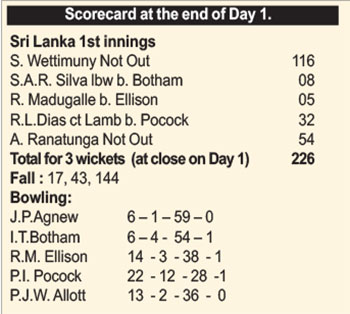 The departure of Roy Dias brought the pugnacious 21 year old Ranatunga to the center. Looking every bit as cheeky as he always was, Ranatunga quickly set about scuttling the bowling with an array of off side shots, using no noticeable back lift and curbing himself until the ball was almost upon him. He would then lean into it with some muscle and scuttle it away, be it from backward point to long-on. Anything that was on his pads, he would deftly deflect backward of square, with the assurance of a man who was in complete control of himself.
The departure of Roy Dias brought the pugnacious 21 year old Ranatunga to the center. Looking every bit as cheeky as he always was, Ranatunga quickly set about scuttling the bowling with an array of off side shots, using no noticeable back lift and curbing himself until the ball was almost upon him. He would then lean into it with some muscle and scuttle it away, be it from backward point to long-on. Anything that was on his pads, he would deftly deflect backward of square, with the assurance of a man who was in complete control of himself.
Wettimuny meanwhile, was increasingly stricken with cramp and was content on playing second fiddle. This allowed Ranatunga to take on the bulk of the bowling. The leftie would busily square drive or punch on the off, picking gaps or creating them, while gorging himself on the bowling as if it were a plate of rice. At tea, Sri Lanka were 173 for three and by the end of the day’s play 30 minutes before the scheduled close, they were 226 for three. Amply blessed with patience and style, Wettimuny returned unbeaten on 116 on a day he could do no wrong even if he tried. Ranatunga remained unbeaten on 54.
To be continued tomorrow.
Sports
England face Australia in the battle of champions

The first truly heavyweight clash of this expanded T20 World Cup format comes freighted with both history and subplots. A rematch of the 2010 World T20 final at Kensington Oval, the match pits Jos Buttler’s defending champions – who are aiming to become the first team to retain the trophy – against the Australian winning machine, victors at the 2021 edition and current world title-holders in Test and ODI cricket. And that’s before you throw in the Ashes for afters.
Already there is added pressure on England, after the rain in Bridgetown led to a share of the points in their opener against Scotland (and that having conceded 90 runs from 10 overs without taking a wicket in a tepid bowling display). Lose to their oldest rivals and it will leave their Super 8 prospects open to being waylaid by the perils of net run-rate calculations, or worse.
The Scotland match was the third abandonment in five suffered by England, after a rain-affected home series against Pakistan, which has clearly hampered their readiness for this campaign after almost six months without playing T20 together. It does not take much for a side to click in this format – and England looked in decent shape when they did get on the field against Pakistan – but Buttler will be anxious for things to go their way on Saturday, if only to avoid further questions referencing the team’s disastrous ODI World Cup defence last year.
Australia, under the laidback leadership of Mitchell Marsh would love nothing more than to add to the English sense of jeopardy – having helped bundle them out of the tournament in India on the way to taking the crown. Their head to head record is less impressive in T20 however, with England having won six of the last seven completed encounters, as well as that 2010 final.
Despite a wobble with the bat, Australia avoided mishap against Oman earlier in the week, the experience of David Warner and Marcus Stoinis shining through in difficult batting conditions. Surfaces in the Caribbean – not to mention those games staged in the USA – have already had teams scratching their heads; rather than the “slug-fest” England had prepared for, following a high-scoring tour of the Caribbean in December, it looks as if boxing smart may be the way to go.
Speaking of Warner, this could be the last time he faces up against England in national colours – and another match-winning contribution would likely reduce the chances of them meeting again in the knockouts. On the other side of the card is Jofra Archer, fresh from an emotional maiden outing at Kensington Oval and ready to take on Australia for the first time in any format since 2020. Can Mark Wood fire up England’s campaign, as he did during last summer’s Ashes? Will Pat Cummins be back to harass the old enemy once again? Seconds out, it’s almost time to rumble.
Cummins is set to return after being rested for the Oman game, which saw Mitchell Starc leave the field with cramp. Starc is understood to be fine and could keep his place – which would likely see Nathan Ellis miss out. Marsh is still not fit to bowl, with Australia likely to continue with the allrounder combination of Stoinis and Maxwell to give them cover.
Australia (probable XI): David Warner, Travis Head, Mitchell Marsh (capt), Glenn Maxwell, Marcus Stoinis, Josh Inglis (wk), Tim David, Pat Cummins, Nathan Ellis/Mitchell Starc, Adam Zampa, Josh Hazlewood
The one change England may consider is Reece Topley coming in for Wood, with the expectation that there will be some rotation among the seamers through the course of the tournament.
England (probable XI): Phil Salt, Jos Buttler (capt & wk), Will Jacks, Jonny Bairstow, Harry Brook, Liam Livingstone, Moeen Ali, Chris Jordan, Jofra Archer, Adil Rashid, Reece Topley/Mark Wood
[Cricinfo]
Sports
South Africa up against their bogey team in batter-unfriendly New York
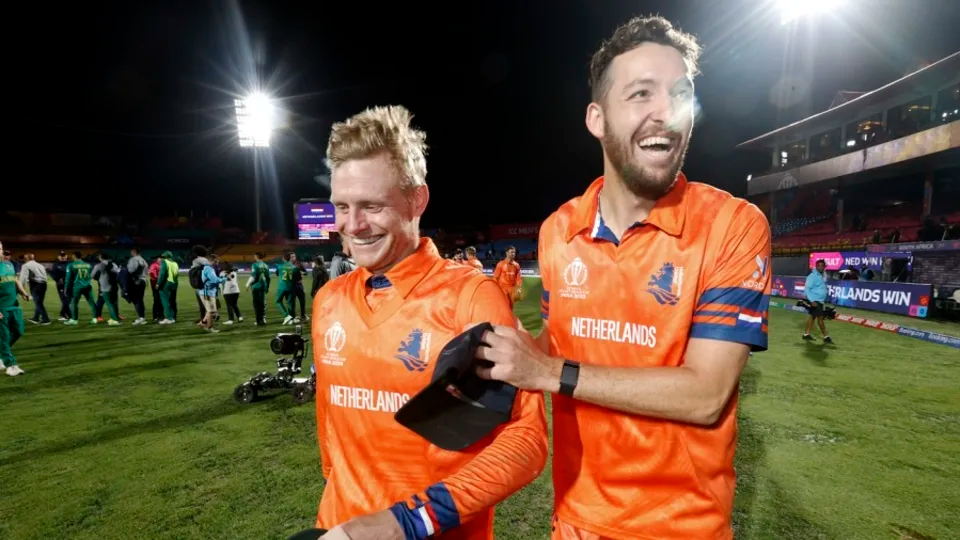
Once is coincidence, twice is a clue, and three times is proof.
To paraphrase Agatha Christie, that is the narrative around South Africa’s meeting with Netherlands at this T20 World Cup.
The Dutch beat South Africa at the 2022 tournament and ended their semi-final hopes in a match where South Africa appeared to be sleep walking, and then beat them again at the 2023 ODI World Cup, where they exposed South Africa’s vulnerability in the chase. If they to do the treble, not only will Netherlands take the lead in Group D, but they will offer conclusive evidence of the threat they pose to Full Members, especially South Africa.
Of course, it will take some doing after South Africa’s opening performance against Sri Lanka, where they reduced their opposition to their lowest T20I total and chased it down in fairly straightforward fashion thanks to the most stable middle-order of their white-ball era. In Aiden Markram, Tristan Stubbs, Heinrich Klaasen and David Miller, South Africa have bankers and big-hitters and, for this match, they also have the advantage of experience. They’ve already played at Eisenhower Park, and have first-hand knowledge that run-scoring doesn’t come easily;Klassen said they are prepared to use their “cricket brains” and play “smarter cricket”.
But the conditions could be good news for Netherlands, who are not naturally a line-up of big hitters and build their innings on a foundation of turning ones into twos. In other words, they tend to take a slightly more conservative approach to batting, which may work well here, but they’ll be wary of the uneven bounce of the surface and will have to come up with plans to counterattack especially against South Africa’s seamers. Their own bowlers were exemplary in Dallas and will look to build on that performance against a line-up that will likely be more proactive than Nepal’s, but who they have managed to keep quiet not once, but twice in the past. Third time’s the charm, they say.
Anrich Nortje’s stunning return to form against Sri Lanka means South Africa may not have to tinker with the bowling combination, and Gerald Coetzee and Tabraiz Shamsi may have to wait their turns to get a game. The batting line-up should be unchanged, with no space for Ryan Rickelton yet.
South Africa: Quinton de Kock (wk), Reeza Hendricks, Aiden Markam, Tristan Stubbs, Heinrich Klaasen (wk), David Miller, Marco Jansen, Keshav Maharaj, Kagiso Rabada, Ottneil Baartman, Anrich Nortje
Conditions in New York may tempt Netherlands to include an extra seamer and they have Kyle Klein in their squad. But it could come at the expense of a shortened batting line-up and they may not want to risk that.
Netherlands: Michael Levitt, Max O’Dowd, Vikramjit Singh, Sybrand Engelbrecht, Scott Edwards (capt, wk), Bas de Leede, Teja Nidamanuru, Logan van Beek, Tim Pringle, Paul van Meekeren, Vivian Kingma
[Cricinfo]
Latest News
Mustafizur, Rishad, Hridoy dazzle in Bangladesh’s tight two-wicket win over Sri Lanka
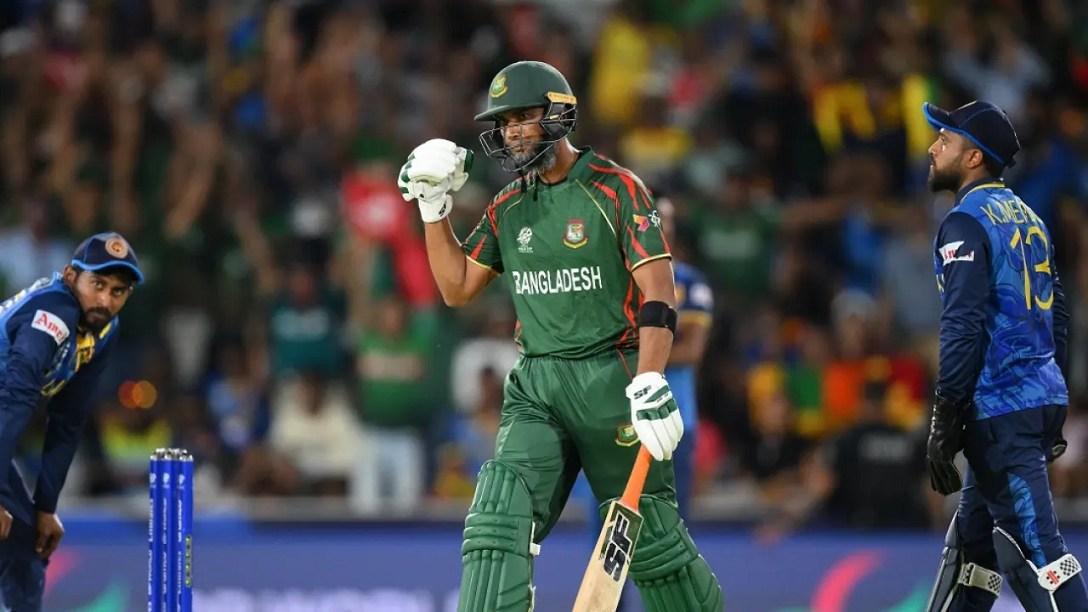
Nuwan Thushara’s last over brought Sri Lanka screaming back into the match,as he first bowled Rishad Hossain, and then nailed Taskin Ahmed in front of the stumps with a pinpoint swinging yorker. This left Bangladesh eight wickets down, with 12 runs still to get.
However, the experienced Mahmudullah was at the crease for Bangladesh, and despite some further nervy moments, pushed Bangladesh across the line off the last ball of the 19th over.
But this was a match chiefly decided by Bangladesh’s own outstanding bowling. Mustafizur Rahman was the best among them, using shorter lengths and his cutters efficiently, to claim figures of 3 for 17. Rishad Hossain’s three-for through the middle overs also kept Sri Lanka quiet.
Mustafizur was instrumental in Sri Lanka’s downward spiral through the middle overs, which culminated in a crash-and-burn end. Ultimately, their inability to find boundaries, or even rotate strike against good Bangladesh bowling resulted in their downfall. A score of 125 for 9 always seemed poor on a decent pitch, even if their bowlers made a match of it in the end.
Brief scores:
Bangladesh 125 for 8 in 19 overs (Towhid Hridoy 40, Litton Das 36; Dhanajaya de Silva 1-11, Nuwan Thushara 4-18, Wanidu Hasaranga 2-32, Matheesha Pathirana 1-27) beat Sri Lanka124 for 9 in 20 overs (Pathum Nissanka 47, Dhananjaya de Silva 21; Tanzim Hasan Sakib 1-24, Taskin Ahmed 2-25, Mustafizur Rahman 3-17, Rishad Hossain 3-22) by two wickets
[Cricinfo]





















